标签:
一、声明和使用变量的步骤:
①声明一个变量以分配空间:根据类型开辟空间。
int a; int 占4个字节
②为变量赋值:将数据存入空间。
a=20;
③使用变量:取出数据,使用。
System.out.println(a);
二、标识符命名规则
变量名=首字符+其余部分
首字符:字母、下划线、’$’
其余部分:数字、字母、下划线、’$’
变量名:应避开关键字,如int int=10;第二个int就是关键字,不能使用
符合驼峰命名法:mySocre,若名字由多个单词组成,从第二个单词开始,首字母均为大写
简单明了表示变量的作用,首字母小写
Java关键字(保留字)
Java有51个关键字,不能使用保留关键字来命名类、方法和变量。
数据类型
boolean int long short byte float double char class interface
流程控制
if else do while for switch case default break continue return try catch finally
修饰符
public protected private final void static strictfp abstract transient synchronized volatile native
操作
package import throw throws extends implements this super instanceof new
其他
三、变量Code
①先声明后赋值

1 public class VarDemo
2 {
3 public static void main(String []args){
4 //先声明后赋值
5 int number;
6 number=1;
7 System.out.println(number);
8 }
9 }

②声明的同时做初始化

1 public class VarDemo
2 {
3 public static void main(String []args){
4 //声明的同时做初始化
5 //int date1=10;
6 //System.out.println(date1);
7 }
8 }

③方法中所声明的变量必须初始化后才能使用(错误code)

1 public class VarDemo
2 {
3 public static void main(String []args){
4 //方法中所声明的变量必须初始化后才能使用
5 //int date2=20;
6 //System.out.println(date2);
7 }
8 }

④同时声明多个变量(错误code)

1 public class VarDemo
2 {
3 public static void main(String []args){
4 //同时声明多个变量
5 int date3,date4,date5=100;
6 System.out.println(date3);
7 System.out.println(date5);
8 }
9 }

同时声明多个变量(错误code)

1 public class VarDemo
2 {
3 public static void main(String []args){
4 //同时声明多个变量
5 int date3=date4=date5=100;
6 System.out.println(date3);
7 System.out.println(date5);
8 }
9 }
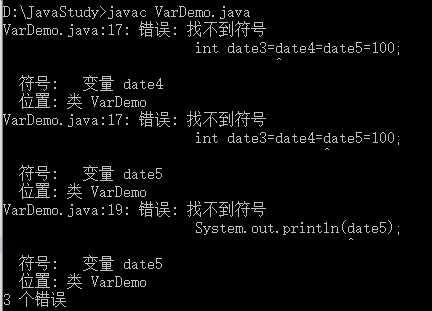
同时声明多个变量(正确code)

1 public class VarDemo
2 {
3 public static void main(String []args){
4 //同时声明多个变量
5 int date3=20,date4=50,date5=100;
6 System.out.println(date3);
7 System.out.println(date5);
8 }
9 }
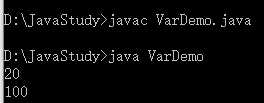
⑤变量名不能声明同名变量(错误code)

1 public class VarDemo
2 {
3 public static void main(String []args){
4 //变量名不能声明同名变量
5 int date3=20;
6 int date3=10;
7 System.out.println(date3);
8 }
9 }

⑥关键字不能作为变量名(错误code)

1 public class VarDemo
2 {
3 public static void main(String []args){
4 //关键字不能作为变量名
5 int final=20;
6 System.out.println(final);
7 }
8 }

⑦变量区分大小写

1 public class VarDemo
2 {
3 public static void main(String []args){
4 //变量区分大小写
5 int mySocre=20;
6 int myscore=30;
7 System.out.println(mySocre);
8 System.out.println(myscore);
9 }
10 }
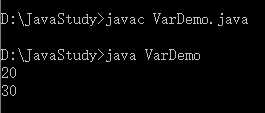
⑧变量中的值可以进行修改

1 public class VarDemo
2 {
3 public static void main(String []args){
4 //变量中的值可以进行修改
5 int mySocre=20;
6 int myscore=30;
7 mySocre=100;
8 System.out.println(mySocre);
9 System.out.println(myscore);
10 }
11 }
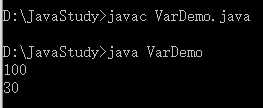
四、数据类型(一)
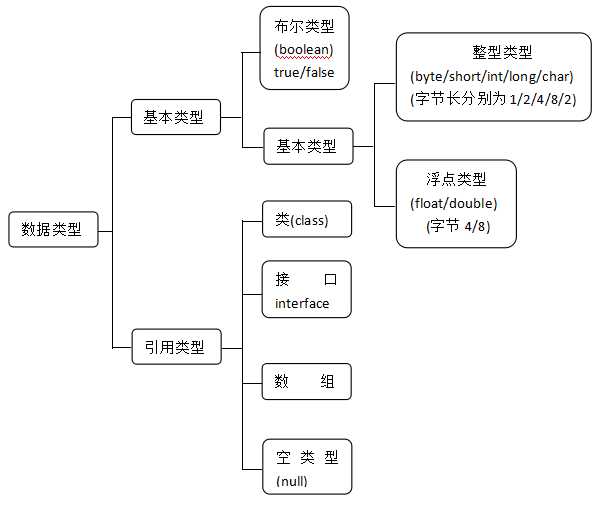
|
数据类型 |
关键字 |
在内存中占用字节数 |
取值范围 |
默认值 |
|
布尔型 |
boolean |
1个字节(8位) |
true,false |
false |
|
字节型 |
byte |
1个字节(8位) |
-128~127 |
0 |
|
字符型 |
char |
2个字节(16位) |
0~216-1 |
‘\u0000’ |
|
短整型 |
short |
2个字节(16位) |
-215~215-1 |
0 |
|
整型 |
int |
4个字节(32位) |
-231~231-1 |
0 |
|
长整型 |
long |
8个字节(64位) |
-263~263-1 |
0 |
|
单精度浮点型 |
float |
4个字节(32位) |
1.4013E-45~3.4028E+38 |
0.0F |
|
双精度浮点型 |
double |
8个字节(64位) |
4.9E-324~1.7977E+308 |
0.0D |
五、数据类型code
①字节型

1 public class DataDemo
2 {
3 public static void main(String [] aras){
4 //字节
5 byte age=20;
6 System.out.println(age);
7 }
8 }
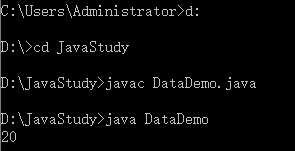
字节型超出范围(错误code)

1 public class DataDemo
2 {
3 public static void main(String [] aras){
4 //超出最大范围
5 byte age=128;
6 System.out.println(age);
7 }
8 }

②类型不兼容(错误code)

1 public class DataDemo
2 {
3 public static void main(String [] aras){
4 //类型不兼容
5 byte age=20;
6 age=true;
7 System.out.println(age);
8 }
9 }

③整型

1 public class DataDemo
2 {
3 public static void main(String [] aras){
4 short number1=200;
5 int number2=100;
6 long number3=2000L;
7 System.out.println(number1);
8 System.out.println(number2);
9 System.out.println(number3);
10 }
11 }

④单精度浮点型(错误code)

1 public class DataDemo
2 {
3 public static void main(String [] aras){
4 float number4=10.5;
5 System.out.println(number4);
6 }
7 }

单精度浮点型(正确code)

1 public class DataDemo
2 {
3 public static void main(String [] aras){
4 float number4=10.5f;
5 System.out.println(number4);
6 }
7 }

⑤双精度浮点型

1 public class DataDemo
2 {
3 public static void main(String [] aras){
4 double data=10.456;
5 double data2=.125;
6 double data3=0.3456e3;
7 System.out.println(data);
8 System.out.println(data2);
9 System.out.println(data3);
10 }
11 }
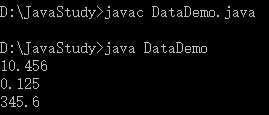
⑥布尔型

1 public class DataDemo
2 {
3 public static void main(String [] aras){
4 boolean flag=true;
5 System.out.println(flag);
6 }
7 }

标签:
原文地址:http://www.cnblogs.com/wzy330782/p/5240445.html